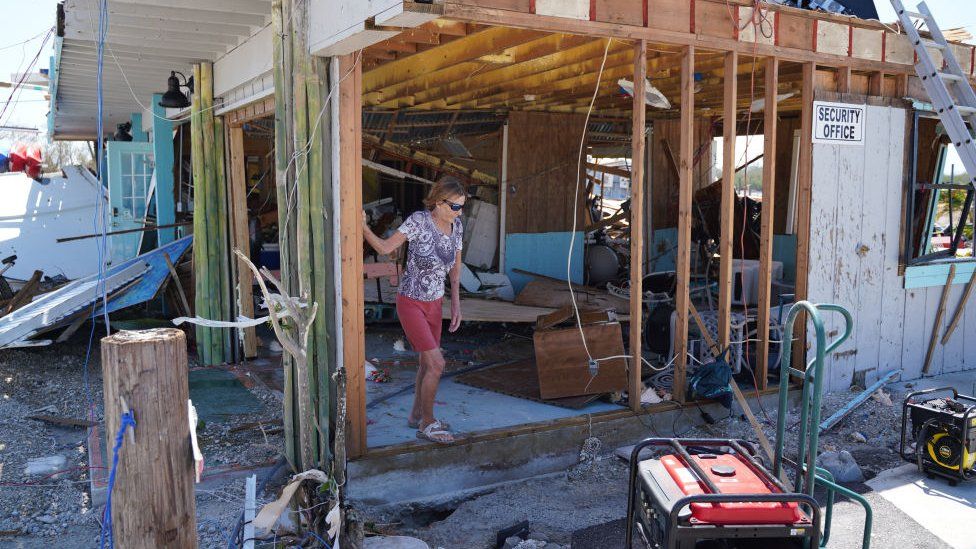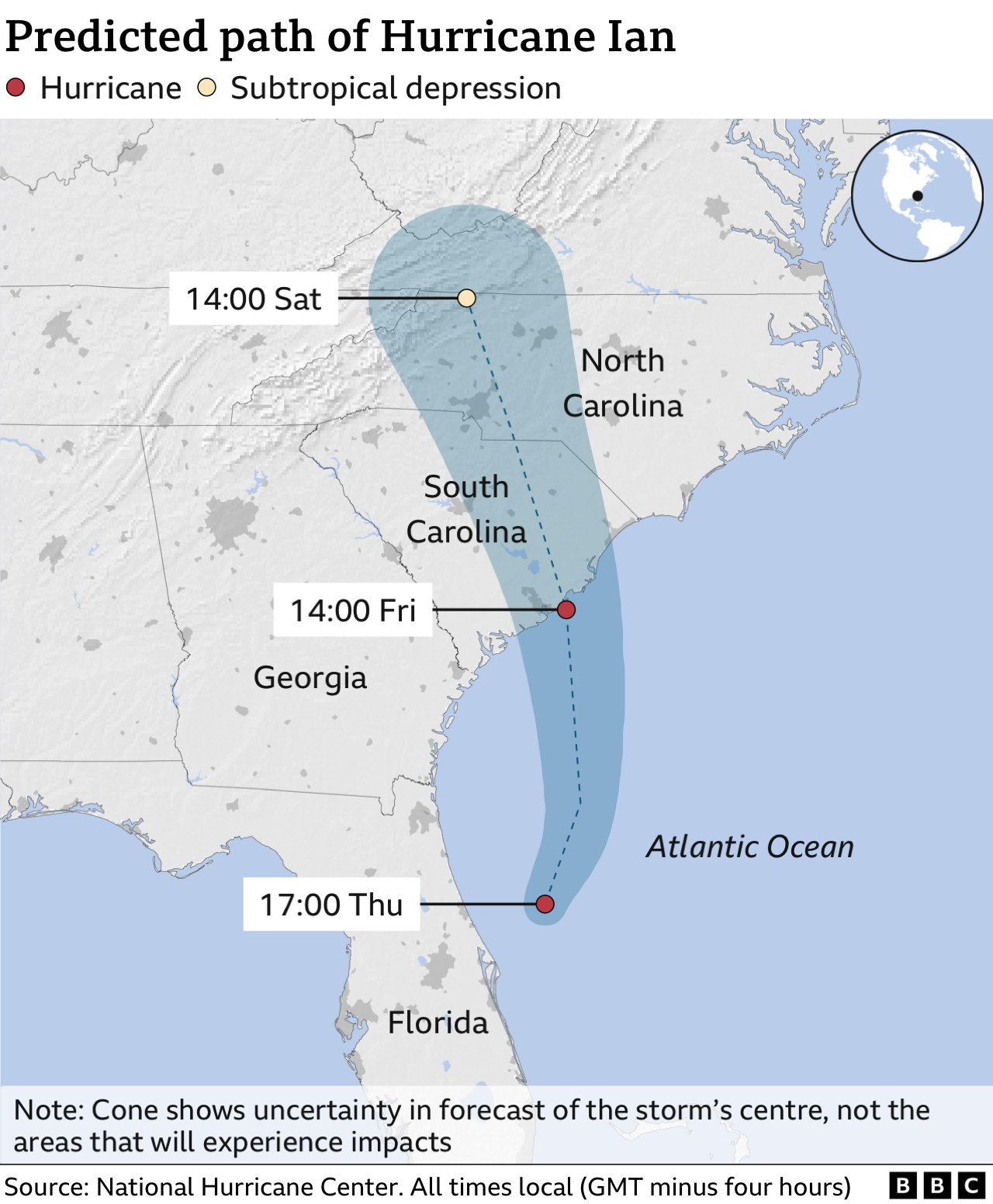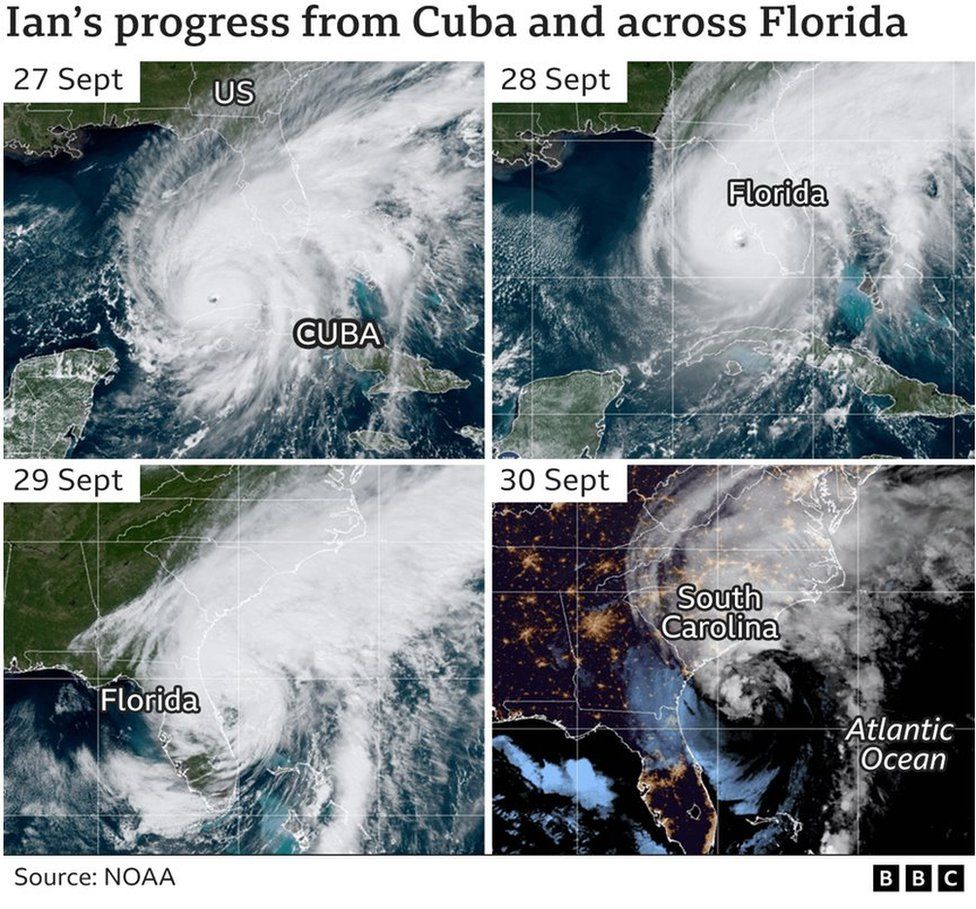Hurricane Ian: Survivors speak of ‘brutal’ storm as Florida counts cost
Survivors #Survivors

By Bernd Debusmann Jr & John Sudworth & Flora DruryBBC News, Florida and London
Image caption,
Frankie (L) and Kendrick Romulus stand next to a boat that crashed into their apartment complex in Fort Myers, one of the worst affected areas
The damage left behind in Hurricane Ian’s wake is obvious: the boats piled up in the streets in Fort Myers, the pier ripped in half in Naples.
What authorities in Florida don’t know yet is how many people died.
US President Joe Biden has warned that Ian – which hit on Wednesday as a category four storm – could be the deadliest in the state’s history.
The focus has now turned to a massive search and rescue operation as Ian heads towards North and South Carolina.
So far, more than 700 people had been rescued from Charlotte and Lee Counties, the two worst hit areas, Florida’s Governor Ron DeSantis said on Thursday. He warned both counties had been left basically “off the grid” following power outages, which hours later were still affecting some 2.2 million homes and businesses across the state.
However, he refused to speculate on the number who may have been killed, and it is unclear how many people are still awaiting help. In particular, there are fears for two barrier islands, just off the coast, which were “hit with really biblical storm surges” but remained cut off from the mainland, Mr DeSantis said.
Joseph Tiseo, a Charlotte County commissioner, confirmed to the BBC they had recorded at least 10 deaths since the “brutal” storm – although it was unclear how many were as a direct result of the hurricane. First responders were still trying to reach some of those who had called for help hours earlier, he said.
“We had a bunch of calls coming in when the storm was approaching, but we had to shut down 911 operations because we couldn’t put our first responders on the roads during a hurricane event,” he explained.
Elsewhere, survivors described how the flooding had trapped them in their homes, facing life or death decisions as the water gushed in.
In Fort Myers, Charlotte County, Janelle Thil was forced to swim to safety when her ground floor apartment began to flood.
“[My neighbours] got my dogs and then I jumped out of the window and swam,” the 42-year-old told news agency AFP.
Even homes further inland found themselves flooded. In Orlando, as much as 35cm (14ins) of rain fell, with rescuers going door to door to get people out of their homes.
But some did not have the luxury of waiting for help.
“You have to either swim or drown,” one woman in Orlando told CBS News, the BBC’s partner in the US, after escaping her home through a window.
Back in Fort Myers, Patrick Hallquist told the BBC the storm surge was “the worst” he had ever seen – despite having been “in quite a few hurricanes”. Gov DeSantis described the surge as having caused a “500-year flood event”.
Before and after pictures show the level of damage done, turning roads into rivers, destroying bridges, and wiping out entire communities of mobile homes.
“It was terrifying, because you’re helpless,” Kim, who lives at the Sun Seekers mobile home park in Fort Myers, told the BBC as she waded through the debris left behind. “We had no [phone] service to call anyone – but no one would have come anyway.”
Media caption,
Watch: “I hid in my bath tub all day and night as the hurricane hit my mobile home.”
Gov DeSantis described his own shock after visiting the city.
“To see a house just sitting in the middle of Estero Bay, literally must have gotten picked up, flown because of the massive wind speed and the storm surge and deposited in a body of water,” he said.
“I would say the most significant damage that I saw was on Ford Myers Beach, some of the homes were wiped out, some of its was just concrete slabs.”
Even areas which did not take the full force of the storm sustained serious damage. In Naples, to the south of Fort Myers, the BBC found a city half in darkness, its iconic pier smashed in half.
A concession stand – which just days ago marked the halfway point on the pier – now stands precariously over the water, with splintered pieces of wood hanging off.
About a block from the beachfront, some roads remain impassable and underwater, while others have been left covered in mud as the water slowly recedes.

Image source, Getty Images Image caption,
Hurricane Ian shattered Lee County in Florida, with homes on Fort Myers Beach left wrecked after the storm passed
But despite that, Hurricane Ian – which has been downgraded to a category one storm – still poses a danger.
At the governor’s briefing, Kevin Guthrie, director at the Florida Division of Emergency Management warned about “indirect deaths” – the fatalities that can happen after a storm system has passed.
He warned homeowners to watch out for power lines mixed in trees and said no one should be tinkering with generators and chainsaws, or climbing ladders without proper training.
“People need to be extremely careful,” Mr Guthrie said.
“If you do not know how to use a chainsaw. If you do not know how to climb a ladder. If you do not know the difference between a cable line and a power line, you should not be doing that.”

![]()
Elsewhere, the countries which Hurricane Ian collided with are still struggling with the aftermath. In Cuba, which was struck on Tuesday, it caused a total blackout, while in Puerto Rico, the massive clean-up effort continues, after the hurricane hit the Caribbean island last week.
There was also a power blackout there, and 10 days on, more than 269,000 households are still without electricity, according to poweroutage.us.
Puerto Rico was already reeling from Hurricane Fiona, a category one storm that hit just days earlier, on 18 September.
As Hurricane Ian rolls on and attention moves to Florida, many on the island are worried about being forgotten.
“To the people of Puerto Rico, we have not gone away,” President Biden said on Thursday, speaking at the headquarters of the Federal Emergency Management Agency (Fema) in Washington DC.
“I am committed to you and the recovery of the island, we will stand by you no matter how long it takes to get it done.”
Meanwhile, at least one group of scientists believes that the impact of climate change may have increased Ian’s rainfall by as much as 10%.
“Climate change didn’t cause the storm but it did cause it to be wetter,” Michael Wehner, of Lawrence Berkeley National Laboratory, one of the scientists behind the new finding, told AFP news agency.
The impact of climate change on the frequency of storms is still unclear, but we know that increased sea surface temperatures warm the air above and make more energy available to drive hurricanes, cyclones and typhoons. As a result, they are likely to be more intense with more extreme rainfall.
The world has already warmed by about 1.2C since the industrial era began and temperatures will keep rising unless governments around the world make steep cuts to emissions.

![]()

How have you been affected by Hurricane Ian? Share your story by emailing haveyoursay@bbc.co.uk if it is safe to do so.
Please include a contact number if you are willing to speak to a BBC journalist. You can also get in touch in the following ways:
If you are reading this page and can’t see the form you will need to visit the mobile version of the BBC website to submit your question or comment or you can email us at HaveYourSay@bbc.co.uk. Please include your name, age and location with any submission.